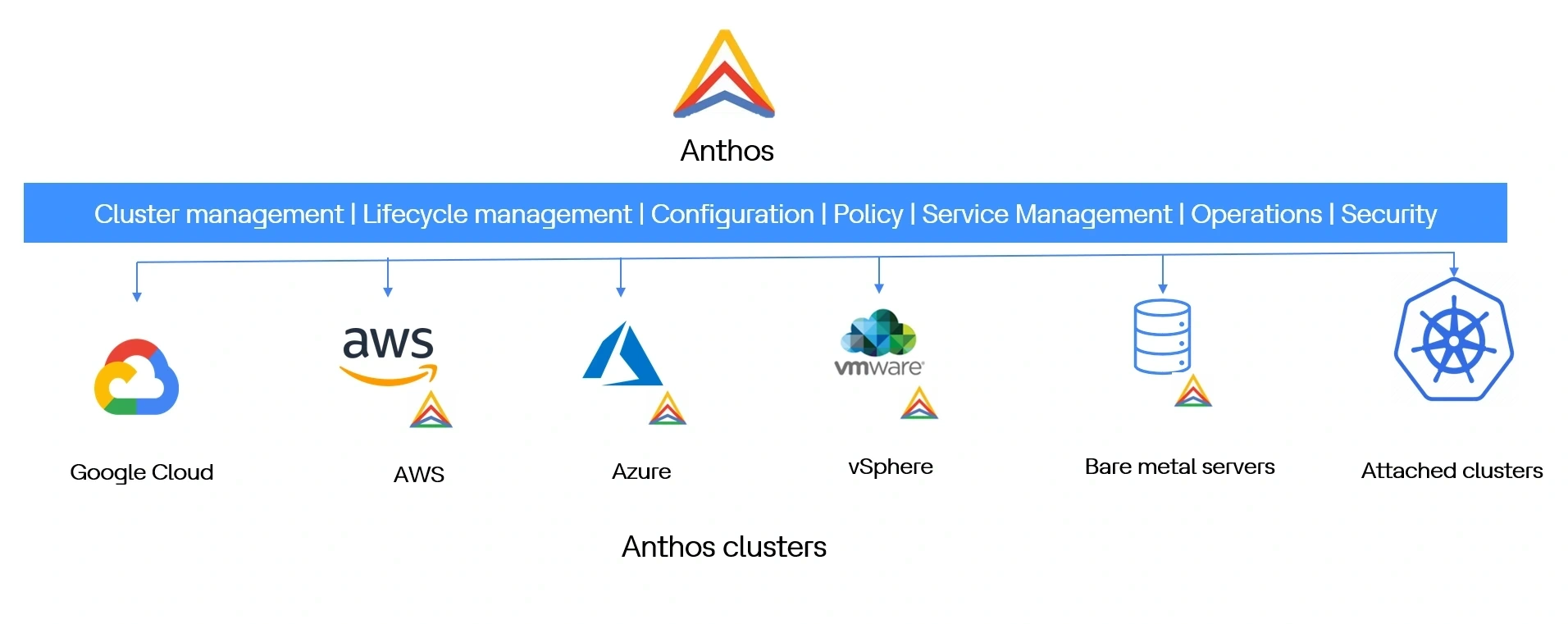In this dynamic era of constant evolution, as companies transition to hybrid and multicloud environments, enterprises face challenges maintaining their applications due to their intricate, costly and rigid natures. To address these issues, enterprises often seek cloud-native solutions to modernize their workloads swiftly and efficiently. Every organization aims to benefit from software for enhanced business outcomes, seeking the ability to run their applications anywhere with multiple providers. Hence, they invest in on-premises platforms and manpower to maintain their infrastructures. They aspire to capitalize on the innovative features, scalability and flexibility of cloud without being locked to a specific cloud provider.
Recognizing these challenges, Google has devised Anthos, a powerful software-based solution.
Anthos is a container-based managed application management platform that unifies infrastructure, service and application management across various public cloud providers (GCP, AWS, Azure) and on-premises in a highly secure manner. With Anthos, users can seamlessly run Kubernetes workloads across diverse environments, supported by a Google cloud-backed control plane for consistent operations. Anthos is built on the Google Kubernetes engine, functioning like Kubernetes’ reliance on containers.

Building blocks of Anthos

Anthos is not a singular product but an umbrella encompassing several services, such as application management, services management, container management, configuration management and operations management.
- Application of configuration management lies at the heart of Anthos, facilitating a centralized configuration to manage the infrastructure and apply policies across multiple Kubernetes clusters residing on different platforms. The components include policy controller, config sync and configuration controller, ensuring that the desired configuration and compliance are in place, helping organizations monitor their environments.
- Anthos service mesh is based on Istio, an open-source platform with features like load balancing, security enforcement, monitoring and traffic management. It helps secure communication across your microservices on-premises and in the cloud. The components of the Anthos service, such as mesh control plane and data plane, help manage, observe and secure the services consistently. Its architecture is defined to decouple business logic from the network layer, facilitating developers' emphasis on the business requirements.
- Cloud Run for Anthos is a native offering fully managed by Google that helps streamline the development and deployment of serverless Kubernetes workloads across hybrid environments. The complexity of Kubernetes is eliminated by Cloud Run for Anthos. The entire lifecycle of Kubernetes workloads is managed by Cloud Run for Anthos.
- Google Kubernetes Engine (GKE) serves as the core of Anthos Service. Anthos GKE makes development, deployment and maintenance of the container workloads easier with the Google Cloud console by providing a single control plane across hybrid and multicloud environments. Multi-cluster Ingress is a Google-hosted service for the Google Kubernetes cluster which provides the features like load balancing to Kubernetes multi-clusters in multi-regions across on-premises and public cloud providers.
- Google Cloud provides a fully managed suite of operations services for observability, which is not limited to infrastructure but extends to applications. It helps in logging, monitoring, debugging, tracing and error reporting to track multiple clusters within Anthos deployed in a hybrid environment.
Features
- Enterprise-ready containers are available at a fast pace through Google Cloud Platform marketplace by providing a reliable, fast, efficient and managed experience
- Built on open-source technology standards, the user cannot get tied to a particular public cloud vendor
- Anthos enables the provisioning and running of Kubernetes clusters anywhere through a Google Cloud-backed control plane in hybrid or multicloud setup
- As part of a cloud-agnostic solution, Anthos offers operational consistency at scale and helps manage the workloads deployed on different clouds from one place at ease
- Anthos service mesh acts as a service control layer for the management of the traffic flow for inter-mesh and intra-mesh
- Anthos on bare metal is a solution independent of the hypervisor layer for cost savings, management overhead and better performance
- Anthos is well integrated with the operations suite of products, which provides visibility to applications deployed in a hybrid environment
Use case - Migrating Cloud Foundry applications using Kf
Cloud Foundry is a platform-as-a-service that streamlines the deployment and operation of stateless applications. It leverages service brokers to bind services to applications and is based on BOSH, which is less flexible than k8s and is not considered ideal for microservices architecture. Furthermore, the future of Cloud Foundry is Kubernetes as a backend for container management to replace BOSH.
For enterprises embracing Kubernetes, migration from Cloud Foundry is the biggest challenge. Kf built by Google acts as a frontend for a Kubernetes cluster. Using Kf for Anthos acts as a single platform to manage and allow developers to use a workflow similar to that utilized in a cloud foundry. Kf's migration journey is in a phased manner — the first phase is application platform standardization, and subsequently, application modernization is performed. Kf helps eliminate licensing costs, reduce support overhead and leverage the policy and configuration features of Anthos for governance.

For the migration to be completed, Kf CLI should be used. A migration plan should be created for the existing cloud foundry application one wants to migrate. It would be in the form of a YAML file containing all the information of the current cloud foundry environment and the application. After creating the migration plan, use 'kf apply' to deploy the application. Once the migration is completed, developers can operate the Kf CLI to operate the applications they moved from the command factory to Kf. Operators are responsible for managing the Kf installation with Anthos tools.
Conclusion
In this revolutionary arena, enterprises are increasingly seeking to adopt the latest technology to modernize their workloads to enhance flexibility and retire the old, outdated systems that are costly and cumbersome to maintain. Anthos emerges as a compelling choice for the enterprise’s cloud strategy empowering them to leverage cloud technologies and operate their workloads in hybrid and multicloud environments to gain a competitive advantage.
While competitors like AWS and Azure have also joined the league offering EKS Anywhere and Azure Arc with similar features, their products are not mature enough compared to Anthos. Google Cloud Anthos has a distinct edge over other cloud providers as Google is committed to open-source technologies with a focus on reliability.
One of the Forrester consultation reports shares insights from Google customers on how Anthos led to the economic gain for their enterprise. On average, the enterprise saw a 4.8x ROI, a 40%-55% increase in platform operations efficiency and a 60%-96% improvement in productivity for security tasks.
References:


